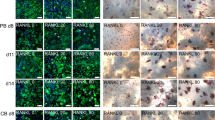Summary
Because of the difficulty in obtaining large, relatively pure populations of osteoclasts, most studies of bone resorption are performed on intact animals or in cultures of embryonic bone rudiments. These experimental systems, however, do not permit detailed analysis of the cellular mechanisms of matrix degradation or of the means whereby resorbing cells attach to the bone surface.
Mononuclear phagocytes, which are probably ontogenetically related to the osteoclast, will resorb bone matrix in tissue culture. Consequently, we have developed an in vitro system whereby the ability of these cells to bind and resorb skeletal matrix can be precisely and individually measured using radioisotopically labeled, devitalized rat bone particles. We have found that when derived from mice, peritoneal macrophages bind approximately 80% of bone particles within the first 40 min of incubation. Significant (P<0.025) net matrix degradation, as defined by the percentage of isotope released from bone cultured with macrophages as compared to that released in the absence of cells, occurs within the first 3 h of culture and proceeds rapidly for at least the first 2 days of incubation. By this time 40%–50% of isotope usually has been released into the medium. Resident peritoneal macrophages appear to mobilize matrix as actively as those which are thioglycollate induced. By comparison, lymphocytes elicit little isotope mobilization from bone, and rat peritoneal exudate macrophages are markedly less efficient (P<0.001) at resorbing rat bone than are macrophages obtained from mice.
Isotope release by peritoneal macrophages represents true cell-mediated resorption and not merely nonspecific mineral mobilization as evidenced by the facts that: (a) the magnitudes of release of isotopes representing the inorganic (45CaCl) and organic (3H-proline) phases of bone are the same, (b) daily buffering of the cultures to pH 7.4 has little effect on45Ca release, and (c) cell-matrix contact is required for optimal mobilization of45Ca or3H.
Similar content being viewed by others
References
Kahn, A.J., Stewart, C.C., Teitelbaum, S.L.: Contact-mediated bone resorption by human monocytes in vitro, Science199:988–990, 1978
Koski, I.R., Poplack, D.G., Blaese, R.M.: A non-specific esterase stain for identification of monocytes and macrophages. In B.R. Bloom, J.R. Davey (eds.): In Vitro Methods in Cell-Mediated and Tumor Immunity, pp. 359–362. Academic Press, New York, 1976
Stewart, C.C., Lin, H., Adles, C.: Proliferation and colony forming ability of peritoneal exudate cells in liquid culture, J. Exp. Med.141:1114–1132, 1975
Julius, M.H., Simpson, E., Herzenberg, L.A.: A rapid method for the isolation of functional thymus-derived murine lymphocytes, Eur. J. Immunol.3:645–649, 1973
Werb, Z., Gordon, S.: Secretion of specific collagenase by stimulated macrophages, J. Exp. Med.142:346–360, 1975
Werb, Z., Gordon, S.: Elastase secretion by stimulated macrophages, J. Exp. Med.142:361–377, 1975
Cohn, Z., Wiener, E.: The particulate hydrolyses of macrophages. I. Comparative enzymology, isolation and properties, J. Exp. Med.118:991–1008, 1963
Lemann, J., Litzow, J.R., Lennon, E.J.: The effects of chronic acid loads in normal man. Further evidence for the participation of bone mineral in the defense against chronic metabolic acidosis, J. Clin. Invest.45:1608–1614, 1966
Bodel, P.T., Nichols, B.A., Bainton, D.F.: Differences in peroxidase localization of rabbit peritoneal macrophages after surface adherence, Am. J. Pathol.91:107–117, 1978
Massry, S.G., Coburn, J.W., Lee, D.D.N., Jowsey, J., Kleeman, C.R.: Skeletal resistance to parathyroid hormone in renal failure. Studies in 105 human subjects, Ann. Intern. Med.78:357–364, 1973
Author information
Authors and Affiliations
Rights and permissions
About this article
Cite this article
Teitelbaum, S.L., Stewart, C.C. & Kahn, A.J. Rodent peritoneal macrophages as bone resorbing cells. Calcif Tissue Int 27, 255–261 (1979). https://doi.org/10.1007/BF02441194
Received:
Revised:
Accepted:
Issue Date:
DOI: https://doi.org/10.1007/BF02441194




